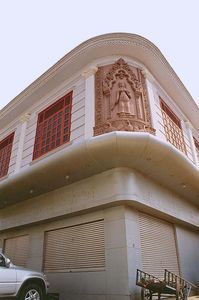Advertisement
Published: August 8th 2007

 Facade
Facade
Notice the unmistakable merging of French Architectural style and Khmer Decorative Style.I hailed from a place where there are only a few structures made of concrete (and not one made of stone). Visiting the Angkor complex with its countless stone structures constructed at a time when the Filipinos were still "up in the trees" was therefore jaw-dropping for me.
The experience also proved incorrect many of my ideas about the Angkor Wat.
The trip to the Angkor complex was an extension of my second ASEAN trip. We started our trip from the former US Military Base in the Philippines, Clark Air Base, which is about 60 kilometers northwest of Manila, the capital city.
The trip would not have been possible if it were not for Air Asia, Asia's budget airline based in Kuala Lumpur, Malaysia.
Up in the air, Siem Reap, the town where the Angkor complex is located, looked not very different from an oversized town in the Philippines. The structures of Siem Reap Airport are modern structures which incorporated various Khmer architectural styles.
We left Kuala Lumpur at about 8:00 in the morning and arrived in Siem Reap about 10:00 in the morning local time (sorry my memory is blurred).
Jan, our contact from

 Lotus Flowers
Lotus Flowers
Flowers for offering in a local templeBaca Villa, picked us up at the airport together with a western couple whose flight from Bangkok had just arrived (after a delay of one hour).
Baca Villa is a small Guest House located in a quite corner of Siem Reap and about 10 minutes away from the Angkor complex and is also a short walk from where most of the commerce is going on.
Perhaps the highlight of our stay at Baca Villa is that we were able to eat the way Filipinos should eat--with a lot of rice helping, pork, vegetable, etc. If any insight should be drawn from our meal in Cambodia and in Malaysia, it should be that Cambodian food is closer to Filipino food than the Malaysian food.
After resting and cooling for awhile (it was very warm in Cambodia when we arrived), we went to the local market to buy some fruits. The market was about 15-20 minutes' walk from Baca Villa. Aside from going to the fruit-stand we also had a side trip to the sellers of trinkets and souvenir items. From the array of goods displayed, I have no doubt about Khmer craftsmanship especially their metallurgical expertise in crafting

 Parrots
Parrots
Baby parrots...I don't know what they are for. Maybe for sacrifice since they are sold next to a temple?things out of Silver.
All the while, while browsing through the different array of goods, I was thinking about my family and how they would feel should I bring home a gift made of pure silver. Alas, the price quoted in US$ were quite prohibitive. So I just toyed with the idea but did not buy a thing.
When we returned to Baca Villa, Jan introduced us to Sem who would be our Tuktuk driver for the next two days. Sem was tall, and quite thin (anyhow, I have not seen a single obese Cambodian most of them being lean-bodied). Aside from being our tuktuk driver, Sem also acted as our tour guide.
According to Sem, the Khmer word "wat" means temple, thus Angkor wat, translates to Angkor Temple.
There were countless temple ruins in the Angkor complex, each of which had its own uniqueness to be explored. Because the temple complex was declared a UNESCO Heritage site, many of the temples are undergoing restoration by different International organizations and Government in cooperation with the Government of Cambodia.
It seemed that our days in Cambodia flew like the wind. Before we knew it, our time

 Temple
Temple
One of temples in townwas over and it was time to say goodbye to Baca Villa and Siem Reap.
Advertisement
Tot: 0.073s; Tpl: 0.011s; cc: 7; qc: 44; dbt: 0.049s; 1; m:domysql w:travelblog (10.17.0.13); sld: 1;
; mem: 1.1mb

 Facade
Facade 
 Lotus Flowers
Lotus Flowers
 Parrots
Parrots
 Temple
Temple


















